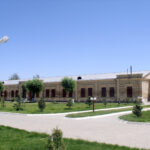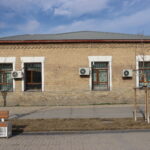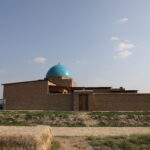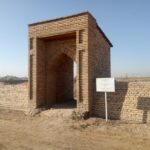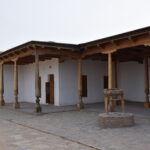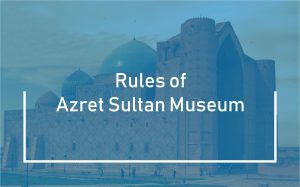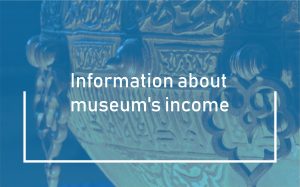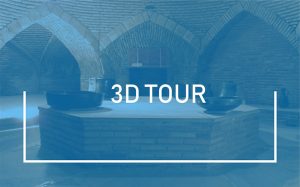The sacred and holy, historical city of Turkestan is being transformed, renewed and becoming more beautiful every day. The city became a regional center in 2019, and on February 13 of this year, at a plenary session, Senate deputies approved the Law on the Special Status of the city of Turkestan, and on March 3, 2025, the Law of the Republic of Kazakhstan No. 165/VIII was approved. These events have a great impact on the study of the history of the ancient city of Turkestan and the development of plans for future development.
In addition, in September last year, in order to obtain the status of «Turkestan – the city of artisans» and membership in the World Organization of Artisans, the Turkestan City Business and Tourism Support Institution applied to the above-mentioned organization. Based on this statement, the exhibition «Ceramic products of the Turkestan Valley» from the collection of ceramic exhibits of the museum reserve fund was opened for members of the special commission of the Organization who arrived in Turkestan. The exhibition features about 200 collections of ceramics and household items from the collections of the museum-reserve. The exhibition was created for two halls of the building, and its exposition plan consists of three main parts.
They:
- XV-X centuries BC From the Bronze Age of the VIII-I centuries. Samples of ceramic products from before the Saka and Uysun periods,
- I-V centuries BC. e. between late antiquity and V-XIV centuries. pottery samples of the early and advanced Middle Ages,
- XV-XVIII centuries. late Middle Ages and XVIII-XIX centuries. modern ceramics.
It is worth noting that when developing the scientific concept and thematic and exposition plan of the exhibition, the collection album of the staff of the National Museum-Reserve «Aziret Sultan» «Ceramic products in the Turkestan Valley» (authors Tuyakbaev M. K., A.M.Egeubaeva) was very helpful
In general, ceramics (Greek. keramike – pottery, keramos – clay) is made from clay with mineral additives and fired to a solid state and is the most common archaeological material since the Neolithic period.
Ceramics played a huge role in people’s everyday life, such as stone, copper, bronze or iron. While people initially tried to make rough pottery, they are currently using it in many fields of science and manufacturing.
In the history of Russian archeology, certain successes have been achieved in the study of natural monuments of the Bronze Age. Therefore, ceramics, which are valuable historical props, form the main category of artifacts from archaeological sites. Studying ceramics, one can tell about the relationships of various groups of the early population, their movements, the peculiarities of economic activity, some aspects of knowledge of the world, the relationship of archaeological cultures and their origin.
The main material obtained during the excavations of settlements and mounds is ceramics. Ceramic ware was a type of tableware used in the household and household, and sometimes for ritual purposes.
Although clay objects are one of the most enduring archaeological finds, pottery is believed to have appeared relatively recently. Pottery originated in ancient agricultural settlements in southwest Asia around 6000 BC. The appearance of the first types of ceramics, mining and processing of ores among the ancient inhabitants of Kazakhstan occurred at the beginning of the Neolithic period – 50,000 years BC.
During the first communal construction, pottery was mainly practiced only by women, while men were engaged in hunting and animal husbandry. Women also engaged in blacksmithing, the simplest types of agriculture, and household chores.
Looking at the dishes, you can talk about the technique of their manufacture. The clay is selected very carefully, sometimes it is delivered several kilometers away. When forming the products, the craftsmen used round stones of different sizes to press the bottom of the vessels. And a table was used as a tool for making dishes, i.e. a machine – a rotating unit. Round stones and wooden knives were used to align the walls of the vessels. And clay was fired in wide-necked furnaces used in everyday life, as well as in the chimneys of melting furnaces. There were times when they were burned in a blazing fire.
Pottery production has reached the stage of «flourishing» in the territories located in settled conditions. The regions of the Syr Darya and the Aral Sea region bordering Central Asia are particularly well developed. This is evidenced by the wide variety of building materials, starting with the dishes found in the excavations of the city in this area. For example, among the vessels of the tribes that inhabited the lower part of the Syr Darya in the 7th-5th centuries BC, one can distinguish: bowls and bowls, glassware, jugs, dishes with a beak-shaped spout.
In the conditions of a nomadic lifestyle in the territory of Central Kazakhstan, ceramics production was carried out by ordering craftsmen as needed at home.
A comparative study of the shape, technique of manufacture and ornament of tableware allows us to determine that for each epoch of the Bronze Age culture a certain shape of tableware corresponded.
In the Early Bronze Age, vessels with straight or slightly convex, sharpened necks and sloping bottoms prevailed. Spruce patterns made with jagged or flat shapes, square, triangular, oval grooves, «sickle-shaped» grooves, as well as ornaments made with nails are common. The entire side and bottom of the vessels were decorated with ornaments. Sometimes the pattern is formed from the intersection of straight, horizontal, zigzag lines and vertical curls filled with triangles.
Vessels of the Middle Bronze Age have a flat bottom, and their throats are rounded or the gap between the throat and the sides is deepened. The pattern is applied using a smooth or finely toothed shape. The most common geometric pattern in this era is a triangle, a meander, cracks, and various intersections of their zigzag line. Jugs with rounded edges are most often decorated with an edge, a neck and an upper part. And in the deepened throats, the images are located in three places – on the neck, slightly higher, and closer to the bottom. Sometimes the bottom is also covered with ornaments.
Most jars from the Late Bronze Age have a rounded shape with rounded side protrusions. Adhesive tapes with oblique and criss-cross projections are glued to their sides. Sometimes, along with other types of drawings, a zigzag line, a curved hole, a herringbone, and «pearls» are drawn on the neck. Sometimes there are also jugs decorated with oval depressions or without them at all.
The craftsmen of the Andronovo period used molds to produce ceramic vessels. In most cases, soft, saturated clay could be placed inside the mold. The use of the mold in the manufacture of ceramics can be traced as follows. The bottom of most vessels is made with strong compression from the inside, which is possible only if there is a solid supporting shape supporting the outside. The thickness of the clay, regardless of the size of the soft samples, ranges from 4 to 6 mm.
When dividing archaeological cultures, scientists pay attention not only to the shape, but also to the ornamentation of ceramics. This is due to the fact that ancient people used ornaments on vessels, on clothes, ornaments and body signs to distinguish their peoples from others. Therefore, the ornament on ceramics can also be considered as an indicator of ethnicity. During the study, it is important to determine not only the method of its manufacture and elements, but also the rules for applying each ornamental system, which will serve as an ethnic indicator. The exhibition was developed in addition to the annual work plan of the museum-reserve, in the future it will be supplemented with new data and valuable exhibits, and artistic design works will be finalized. It is expected that the work on attracting young people and schoolchildren to the exhibition will be developed in cooperation with the teachers of the museum-reserve.
Additionally, an exhibition has been developed outside the annual work plan of the museum-reserve, in the future it will be supplemented with new data and valuable exhibits and its artistic and design work will be improved. It is expected that the work on attracting a large number of young people and schoolchildren to the exhibition will be developed jointly with the museum pedagogy specialists of the museum reserve.
Used literature:
- Tuyakbayev M.K., Egeubayeva A.M. Turkistan zhazirasyn kysh ydystary.Album-kitap. Almaty, 2018, 176 b.
- The history of Kazakhstan from ancient times to the present day. A., 1993 11-16 bb.
- Tuyakbaev M.K. historical topography and development of cities and settlements of the Turkestan Oasis of the XIII-XIX centuries. Almaty, 2009. pp. 8-9
- Saiko E.V. Technique and technology of ceramic production in Central Asia in historical development. Moscow, 1982. pp. 10-12
- Baratov S. Archaeological work in 2000 at the Sherbai burial ground. TAE report on the results of the work in 2000 Archive of the Azret Sultan Museum – Reserve -300 p.
- Levina L.M. Ceramics of the lower and Middle Syrdarya in the first millennium A.D. Moscow, 1971.
- 7. Smagulov E., Grigoriev F., Itenov A. Essays on the history and archeology of medieval Turkestan A. 199. pp. 175-207










